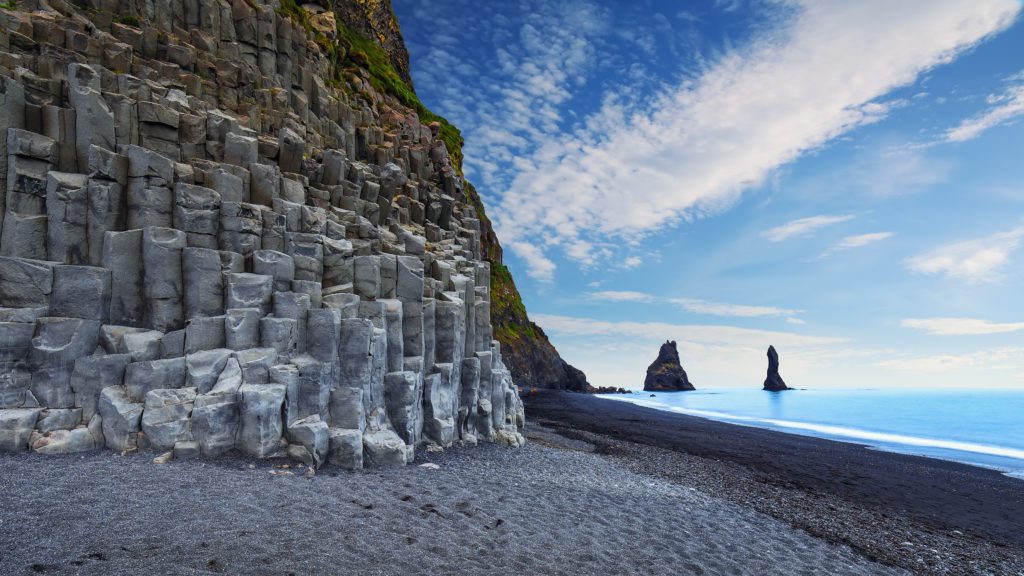
When traveling to Iceland there are so many amazing places to visit. Depending on the interest of each traveler, some places are more interesting than others.
This is especially true when traveling on the south coast of Iceland. There is however no need to worry. We are here you help you with finding the best spot for your road trip by putting Reynisfjara beach on your travel plan.
Reynisfjara beach is one of Iceland’s most famous black sand beaches. Known for it´s raw beauty and natural features which attract thousands of visitors every year.

Where is Reynisfjara Beach and how do I get there?
Located on the south coast of Iceland. It practically in the middle of the island´s south coast and is one of the southernmost point of Iceland.
It´s location is also interesting as it is not only right in the middle of the south coast of Iceland, but it is also in the center of the North Atlantic Ocean. Meaning that when you send on the black sand and steer out to sea you are looking al the way down to Antarctica.
The beach is just outside the town of Vik í Myrdal. The distance between Reynisfjara beach and Reykjavik is about 190 km and close to 250 from Keflavik airport. That’s about two and a half hours drive from the capital area on the Ring Road.
This makes getting to Reynisfjara beach quite easy. Just stay on the Ring Road and head for Vik. Shortly before arriving to Vik you will see a sign where you go off road number one and towards a parking lot for the beach.

What makes Reynisfjara Beach so special?
Reynisfjara is no ordinary beach. It is one of the most beautiful black sand beaches in Iceland. The best way to describe Reynisfjara beach is a place of extremes.
The environment is shaped from the volcanic activity in the area. Over the beach the great volcano Katla, one of Iceland most powerful active volcano, sits under the glacier Mýrdalsjökull.
One the most popular attraction of Reynisfjara Beach is the pillar rocks that form the edge of the east end of the beach.
There is also an extraordinary cave formed under the pillar rock cliff. The cave is easily accessible on low tide but be careful when entering. The waves on the beach can be tricky and appear very sudden. Do not enter the cave or climb on the pillar rock when the water is close.
Dyrhólaey
On the other side of the beach, you can see the amazing cliffs of Dyrhólaey. Dyrhólaey is a promontory on the west side that goes into the Atlantic Ocean and classes with the waves. Sometime in a valiant way. Over time this has created a spectacular stone arch.
Just of shore are the rocky islands called Reynisdrangar.
This unique scenery has not only attracted tourist over the years. Reynisfjara beach has been the stage for many films and tv series. For example, in the hit tv show, Game of Thornes.
So, if you want are a fan of Game of Thrones and want to walk in their footsteps, Reynisfjara beach should definitely be on your travel plan.

When is the best time to visit Reynisfjara Beach?
Reynisfjara beach is open around the year. However, it can be difficult reaching it in winter. The best time to visit Reynisfjara beach is in summer. The beach is an open area so the weather will affect your visit.
The tides will affect your visit as well. On low tide you will see more of the beach than on high tides.
Which one is better depends on you. Whether you want to see waves up close or far out on the sand.
Be careful and keep a safe distance
The most important thing is to always stay safe. Reynisfjara beach is not only known for it´s beauty and incredible scenery. It is also known for powerful waves hitting the beach. These waves can appear fast and without any warning.
There are also strong currents so if you fall into the sea, you could get carried out fast and then you are in real trouble. So, do not take any chances. Read the warning signs and always keep a safe distance from the ocean.
Back